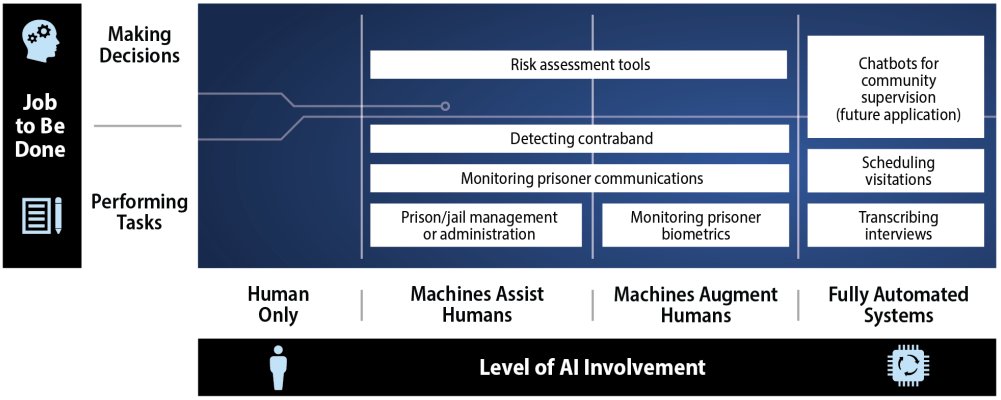Ever been inside a correctional institution? Picture it: The cold steel bars, the echoing hallways. Now imagine if those bars could talk.
They’d probably tell you about their age-old struggle to maintain order and security. But now, they’re getting some high-tech help – from AI (artificial intelligence) video surveillance to cloud computing and real-time data analysis.
In this era of rapid digital transformation, even correctional institutions are stepping into the future with new technology. And we’re not just talking fancy gadgets for fun; these advancements aim at enhancing security measures while addressing critical issues like staffing shortages.
The story doesn’t end there though…
Table Of Contents:
- The Impact of Technology on Correctional Institutions
- Enhancing Security Measures through Advanced Technologies
- Addressing Infrastructure Challenges with Innovative Solutions
- The Role of Building Design in Correctional Facilities Transformation
- Leveraging Technology for Efficient Operations and Inmate Rehabilitation
- FAQs in Relation to Correctional Institution Technology
- Conclusion
The Impact of Technology on Correctional Institutions
Technology is shifting the landscape in correctional facilities, offering novel solutions to old challenges. In fact, 80% of officers report an increase in their incarcerated population, creating a pressing need for effective tools and strategies.
The Role of Digital Transformation in Corrections
Digital transformation plays a critical role here. But how does this translate to the criminal justice system? Utilizing technology to enhance the efficiency and safety of processes is at the core of digital transformation.
Take staffing issues as an example. With 98% reporting decreasing officer levels, innovative law enforcement technologies can step into the gap. Tools such as advanced databases or software designed specifically for corrections can streamline operations and reduce stress on staff members.
This digital shift also brings tangible benefits when it comes to safety measures within these institutions. Sophisticated surveillance systems powered by AI are now used widely across various sectors including correctional facilities – monitoring inmate activities effectively while mitigating security risks.
One Voice United, an organization advocating for safe working conditions for public safety employees, underscores the importance of embracing this technological evolution within our criminal justice system.
Enhancing Security Measures through Advanced Technologies
The advent of advanced technologies, such as AI-based video surveillance systems, is revolutionizing security measures within correctional facilities. Let’s delve deeper into the ways in which these advances are transforming security protocols.
The Promise of AI in Monitoring Inmate Activities
In the challenging world of corrections, high turnover rates among officers can make routine hardware or software training seem daunting. But here’s where artificial intelligence (AI) steps in to give us a hand.
Using facial identification and behavioral analysis capabilities, AI aids in inmate tracking by generating comprehensive activity reports. These tools help to identify potential security risks quickly and accurately so that immediate action can be taken when needed.
This innovative approach not only improves safety but also enhances data collection processes significantly. GUARDIAN RFID, for instance, provides real-time insights into inmates’ activities with its cutting-edge technology solutions tailored specifically for correctional institutions.
 Linke, R. (2017) Design thinking, explained. Retrieved from https://mitsloan.mit.edu/ideas-made-to-matter/design-thinking-explained
Linke, R. (2017) Design thinking, explained. Retrieved from https://mitsloan.mit.edu/ideas-made-to-matter/design-thinking-explained
Addressing Infrastructure Challenges with Innovative Solutions
In the world of correctional facilities, challenges are as diverse as they are numerous. But thanks to innovative solutions like cloud computing and real-time data analysis, these obstacles aren’t insurmountable.
Storing copious amounts of data securely in the cloud is possible, eliminating the need for physical infrastructure. This means that limited physical infrastructure is no longer a bottleneck in processing crucial information about housing, safety, and healthcare needs for residents. Furthermore, it also eases budget constraints by reducing the need for extensive on-site hardware.
Moving beyond storage, let’s talk about decision making – specifically how real-time data analysis comes into play here. The speed at which we can now analyze this wealth of information makes all the difference when quick decisions must be made within prison systems.
To illustrate this point further: imagine being able to adjust security protocols instantly based on current inmate behavior trends or foresee potential issues before they escalate. These possibilities aren’t just figments of our imagination anymore; they’re realities enabled by technology advancements today.
The Role of Building Design in Correctional Facilities Transformation
Building redesigns are stepping up to tackle issues like overcrowding in correctional facilities. They’re creating environments that resemble normality, a crucial factor for successful rehabilitation.
Prison systems have long grappled with overcrowding and its subsequent challenges. But it’s no longer just about cramming more cells into existing structures; instead, modern design approaches consider the impact of physical space on inmate behavior and wellbeing.
Innovative building designs can help law enforcement agencies manage their resources better. By offering inmates a sense of normalcy through well-planned spaces, they promote positive behavioral changes which aid rehabilitation efforts. Learn more at the Correctional Facilities Design & Development Summit here.
The Promise of Redesigning Space Utilization
Redesigned buildings make efficient use of available space while providing sufficient personal areas for each inmate – a direct approach to reduce overcrowding problems.
This new-age prison system promotes healthier interactions between staff and inmates by breaking down traditional barriers. This way, we foster an environment conducive to transformation rather than punishment alone.
Redefining Rehabilitation Through Architectural Innovation
Aesthetic aspects aren’t typically associated with prisons – but think again. Creating familiar settings within confinement walls aids the psychological wellbeing necessary for effective rehabilitation processes.
Fostering such change isn’t merely theoretical; these innovations are making real differences today in correctional institutions across our nation.
Leveraging Technology for Efficient Operations and Inmate Rehabilitation
Technological innovations are not just changing our daily lives, but they’re also transforming the operations within correctional institutions. The use of biometric access tools, thermal cameras, sensors, and RFID technology is becoming more common in these facilities.
Innovations like these allow for a smarter approach to managing prison environments. They make sure that safety measures are stringent while helping inmates on their path towards rehabilitation.
The introduction of biometric access tools has significantly improved security levels. It helps prevent unauthorized entry or exit, making prisons safer than ever before.
Innovations Creating Smart Prisons
Sophisticated thermal cameras give us eyes where human sight fails. They detect unusual activity based on heat signatures, even in complete darkness or through smoke-filled rooms. This capability ensures round-the-clock surveillance without risking officer’s safety.
The integration of sensors provides real-time data about various aspects inside the facility – from monitoring inmate behavior to checking infrastructure integrity. Such information aids decision-making processes leading to efficient operations and potential crisis aversion.
The Impact of Technology on Inmate Rehabilitation
Data-driven evaluations supported by advanced technologies have shown promise in enhancing inmate rehabilitation processes. These methods have been successful in improving incarcerated individuals’ lives with an increased success rate of reintegration as reported by One Voice United’s recent study (source: Link).
FAQs in Relation to Correctional Institution Technology
What technology is used in correctional facilities?
Institutions use tech like biometric tools, AI surveillance, RFID tracking, and cloud computing to boost security and efficiency.
What is an example of technology in corrections?
An example would be AI-based video systems that monitor inmate activities for suspicious behavior using facial recognition.
What technology is being used in correctional facilities to scan for contraband?
Sensors and thermal cameras are employed to spot hidden contraband. This helps keep the environment safer.
How does the corrections system use technology to promote transparency with the public?
Data from real-time analysis can provide insights into operations. It’s shared publicly, promoting transparency about what goes on inside these institutions.
Conclusion
It’s clear that correctional institution technology is changing the game. From boosting security to improving operations, tech is making a big splash.
We’ve seen how digital transformation enhances efficiency and safety. And AI? It’s not just sci-fi anymore; it’s helping monitor inmate activities like never before.
Cloud computing and the utilization of real-time data analytics are playing a critical role in resolving infrastructure issues in correctional facilities. They’re addressing infrastructure challenges head-on in these facilities.
Nor should we overlook building redesigns, which are tackling overcrowding issues while fostering normality for successful rehabilitation. Remember: Tech isn’t only about cool gadgets – it has potential to improve lives too!
All said, correctional institutions are embracing change with open arms, proving they’re more than cold steel bars – they’re becoming smarter prisons for a safer future.


